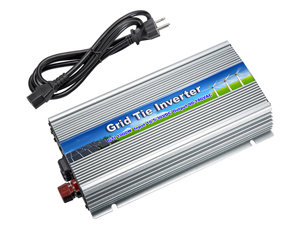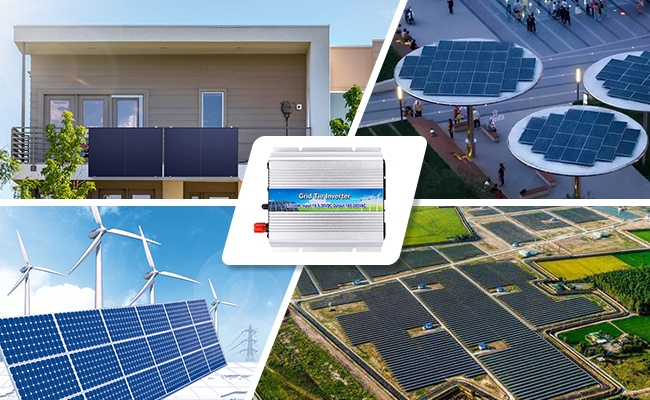The grid tie inverter is generally used in the system of large-scale photovoltaic power stations. Many parallel photovoltaic strings are connected to the DC input end of the same centralized inverter. Generally, 3 phase IGBT power modules with high power are used, and the power is relatively high. Small uses field effect transistors, while using a DSP conversion controller to improve the quality of the power produced, making it very close to a sine wave current.

Basic of grid tie inverter:
The primary role of a grid connected inverter is to convert DC electricity into AC electricity. Solar panels, wind turbines, and other renewable energy sources typically generate electricity in DC form. However, most household appliances and the electrical grid operate on AC electricity. The solar inverter ensures that the electricity generated can be used efficiently within a home or business, or supplied to the grid if there is excess production.
A key feature of grid tie inverters is their ability to synchronize with the utility grid. This synchronization ensures that the AC electricity they produce matches the grid's voltage, frequency, and phase. Without this synchronization, it would be impossible to safely and efficiently feed electricity back into the grid. This capability distinguishes grid tie inverters from standalone inverters used in off-grid systems.
Grid tie pv inverters also play a crucial role in power management. They continuously monitor the electricity generated by the renewable energy source and the electricity consumption of the household or business. When the generated electricity exceeds the consumption, the excess is exported to the grid. Conversely, when the generated electricity is insufficient, additional power is drawn from the grid. This dynamic management helps maximize the use of renewable energy and ensures a reliable power supply.
The on grid tie inverter module is to connect each PV module with an inverter, and each module has a separate maximum power peak tracking, so that the module and the inverter cooperate better. Usually used in 50W to 400W photovoltaic power stations, the overall efficiency is lower than that of string inverters.
Because it is connected in parallel at the AC side, this increases the complexity of the connection on the AC side and makes maintenance difficult. Another problem that needs to be solved is how to connect to the grid more effectively. The simple way is to connect to the grid directly through an ordinary AC outlet, which can reduce the cost and installation of equipment, but the safety standards of the power grid in various places may not allow it. In doing so, the power company may object to the direct connection of the power generating unit to the ordinary outlet of the ordinary household user. Another safety-related factor is whether an isolation transformer (high or low frequency) is required, or the use of a transformerless inverter is permitted.
On grid inverter features:
- High efficiency is required. Due to the high price of solar cells at present, in order to maximize the utilization of solar cells and improve the system efficiency, we must try to improve the efficiency of the inverter.
- High reliability is required. At present, the photovoltaic power station system is mainly used in remote areas, and many power stations are unattended and maintained, which requires the inverter to have a reasonable circuit structure, strict component selection, and requires the grid connected inverter to have various protection functions, such as: input DC polarity reverse protection, AC output short circuit protection, overheating, overload protection, etc.
- The input voltage is required to have a wider range of adaptation. Because the terminal voltage of the solar cell varies with the load and the sunlight intensity. Especially when the battery is aging, its terminal voltage varies widely. For example, for a 12V battery, its terminal voltage may vary between 10V and 16V, which requires the inverter to ensure normal operation within a large DC input voltage range.
Application of grid tie inverter:

- Residential. One of the most common applications of grid tie inverters is in residential solar power systems. Homeowners install photovoltaic (PV) panels on their rooftops to harness solar energy. The electricity generated is in DC form, which needs to be converted to AC to be compatible with household appliances and the utility grid. This not only reduces electricity bills for homeowners but also supports the grid by supplying additional clean energy during peak production times.
- Commercial and industrial applications. Businesses and industrial facilities are increasingly turning to renewable energy to offset their operational costs and reduce their carbon footprint. Grid tie inverters are essential in these larger-scale applications. For instance, commercial buildings often have extensive rooftop spaces that can accommodate significant solar installations.
- Utility-scale solar farms. At the utility scale, solar farms generate vast amounts of electricity, necessitating the use of robust grid tie inverters to manage the energy flow. These inverters must handle high power levels and ensure that the electricity fed into the grid is synchronized correctly in terms of voltage, frequency, and phase.
- Microgrids and energy storage systems. In the context of microgrids, grid tie power inverters are vital for integrating various energy sources and ensuring the microgrid can operate both independently and in conjunction with the main grid. During periods of low renewable generation, stored energy can be converted back to AC and supplied to the grid, enhancing energy reliability and stability.
Grid on inverters play a pivotal role in the integration of renewable energy sources with the electrical grid. By converting DC electricity to AC, synchronizing with the grid, and managing power flow, they enable the efficient and reliable use of renewable energy. The benefits of grid tie inverters extend beyond economic savings, contributing to environmental sustainability and enhancing the reliability of the energy system. Inverter Store provides different types of on grid solar inverter, such as 500W, 600W, 1000W grid tie inverter.
As technology advances and the demand for renewable energy continues to grow, solar grid tie inverters will remain at the forefront of the transition to a cleaner and more sustainable energy infrastructure. By understanding their functionality, benefits, and considerations, homeowners, businesses, and policymakers can make informed decisions and contribute to a greener future.
